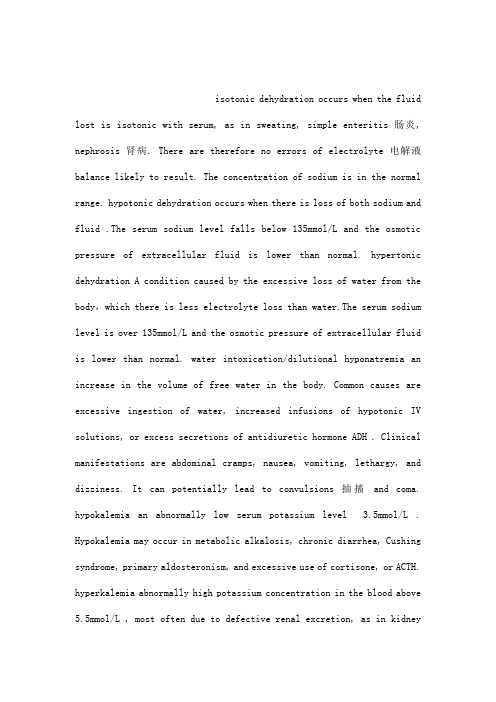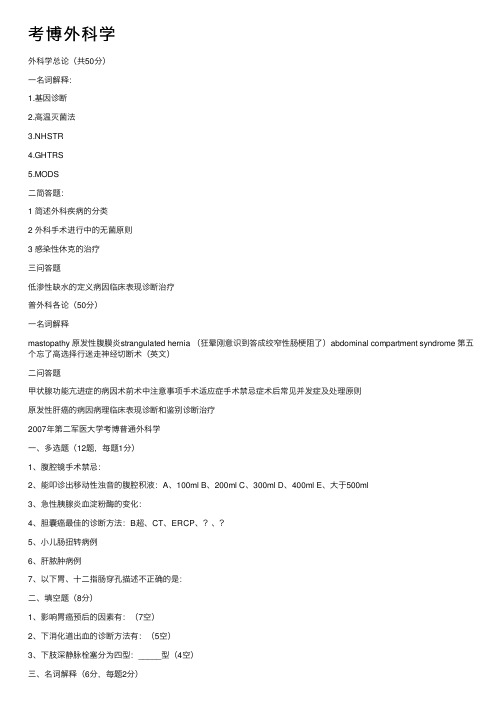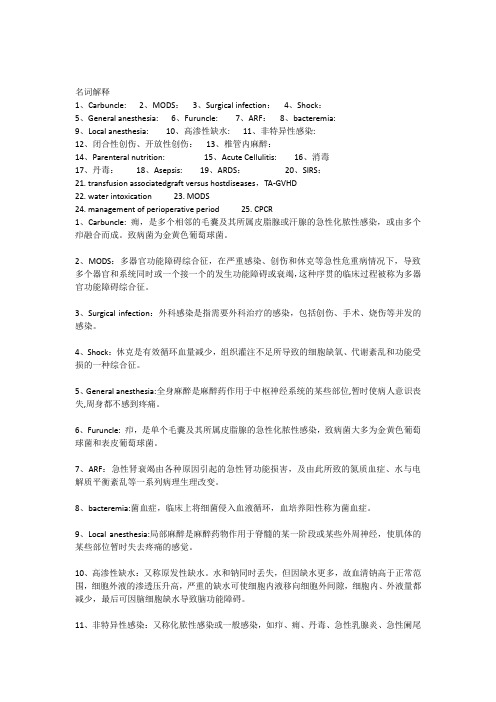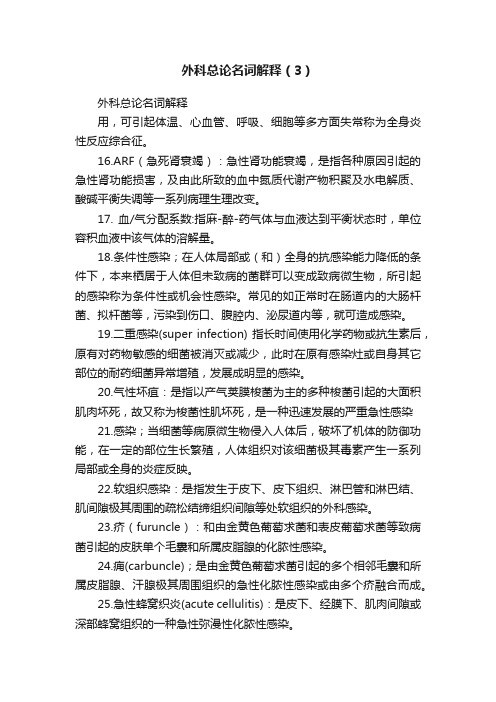外科学总论英文名词解释-专业汇总
(完整版)最全的外科学名词解释

(完整版)最全的外科学名词解释1、灭菌法(sterilition):用物理方法杀灭与手术区和伤口接触物品上的微生物。
2、抗菌法:又称消毒法,用化学方法消灭微生物。
有高压蒸汽,煮沸,火烧。
3、反常性酸性尿:低钾血症时,一方面钾离子由细胞内逸出,与Na,H交换增加,使细胞内液的H浓度降低,导致代谢性碱中毒,另一方面,远曲肾小管NaK交换减少,NaH交换增加,使H排出增多,导致反常性酸性尿4、等渗性脱水:又称混合性脱水,最易发生。
水钠成比例丧失,细胞外液渗透压不变。
5、牵引痛:内脏疾病引起身体体表某部位发生疼痛或痛觉过敏6、会聚现象:牵引痛的部位与患者的内脏部位有一定的解剖关系他们都受同一脊髓节段的后跟7、神经所支配该部位的躯体和内脏痛觉纤维进入同一阶段的脊髓后角内并和同一神经元发生突触联系,即为~ 8、有效循环血量:单位时间内通过心血管系统的血量,依赖充足的血容量,有效地心排出量和良好的周围血管阻力。
9、休克(shock)组织血液灌注不足引起的代谢障碍和细胞受损的病理过程。
10、冷休克:在感染性休克中,出现血管收缩,皮肤苍白,湿冷,甚至有紫绀少尿或无尿。
11、中心静脉压(CVP)代表右心房或者胸腔段腔静脉内压力的变化可反映全身血容量与右心功能之间的关系12、MODS:在严重创伤、感染和休克时,原无器官功能障碍的患者同时或者在短时间内相继出现两个以上器官系统的功能障碍以致机体内环境的稳定必须靠临床干预才能维持的综合征。
13、ARF:急性肾衰肾排泄功能在短时间内迅速减退,血尿素氮及血肌酐持续升高肌酐清除率下降到正常一半,引起水,电解质,酸碱平衡失调及氮质血症。
14、ARDS急性呼吸窘迫综合症:急性呼吸衰竭,共同病理变化为肺血管内皮及肺泡损伤,肺间质水肿等病人呼吸急迫,困难并有缺氧表现。
15、SIRS全身炎症反应综合症:表现体温>38或<36,心率>90次/分,呼吸急促>20次/分或过度充气,PaCO2<4.3kPa,白细胞>12x10^9/L或<4x10^9/L,或未成熟白细胞>1/10.血液透析(hemodialysis)利用血液透析器代替部分肾功能,清除血液中的蛋白质有害物质,纠正体内电解质和维持酸碱平衡16、择期手术:某些外科疾病,施行手术迟早不影响治疗效果,应做好充分的手术准备。
外科总论名词解释

1、无菌术(asepsis):是临床医学的一个基本操作规范。
就是针对微生物及其感染途径所采取的一系列预防措施。
其内容包括灭菌、消毒法、操作规则及管理制度。
2、休克(shock):是机体有效循环血容量减少、组织灌注不足、细胞代谢紊乱和功能受损的病理过程,它是一个由多种病因引起的综合症。
3、感染性休克(septic shock):是外科多见和治疗较困难的一类休克。
可继发于以释放内毒素的革兰阴性杆菌为主的感染,如急性腹膜炎、胆道感染、绞窄性肠梗阻及泌尿系感染等,称为内毒素性休克。
4、全身炎症反应综合症(SIRS):(1)体温>38。
C或<36。
C;(2)心率>90次/分;(3)呼吸急促>20次/分或过度通气,PaCO2<4.3kPa;(4)白细胞>12*109/L或<4*109/L,或未成熟白细胞>10%。
5、多器官功能衰竭综合症(MODS):是指急性疾病过程中两个或两个以上的器官或系统同时或序贯发生功能障碍。
6、急性肾衰竭(ARF):是指由各种原因引起的肾功能损害,在短时间(几小时至几日)内出现氮质代谢产物积聚,水电解质和酸碱平衡失调及全身并发症,是一种严重的临床综合病症。
7、少尿(oliguria):少于400ml/d;无尿(anuria):少于100ml/d。
8、尿毒症(uremia):是各种晚期的肾脏病共有的临床综合征,是慢性肾功能衰竭进入终末阶段时出现的一系列临床表现所组成的综合征。
9、急性呼吸窘迫综合征(ARDS):是因肺实发生急性弥漫性损伤而导致的急性缺氧性呼吸衰竭,临床表现以进行性呼吸困难和顽固性低氧血症为特征。
10、急性肺损伤(ALI):与ARDS为同种综合征的两个发展阶段,早期表现为ALT,而ARDS为最严重阶段。
11、急性胃肠功能障碍(AGD):是继发于创伤、烧伤、休克和其他全身性病变的一种胃肠道急性病理改变,以胃肠道粘膜损害以及运动和屏障功能障碍为主要特点。
外科学名词解释

外科学名词解释外科学(Surgery)是一门研究和治疗疾病、创伤和异常情况的医学专业,主要通过手术操作来进行治疗和修复。
外科学涵盖广泛的领域,包括普通外科、神经外科、心胸外科、整形外科、胃肠外科等。
以下是对一些外科学常见名词的解释:1.手术(Surgery):手术指通过在病人身体上进行切割、缝合或修复,来治疗疾病、损伤或异常情况的医疗工艺。
2.麻醉(Anesthesia):麻醉是一种通过使用药物来减轻或消除病人疼痛和产生失去意识的状态,使得手术过程可以无痛苦地进行的过程。
3.切口(Incision):切口是外科手术时切开皮肤和其他组织以便进入人体内部的过程。
切口的大小和位置根据手术的目的和需要来确定。
4.缝合(Suture):缝合是在手术过程中将切开的皮肤和其他组织以及器官部分进行接合和固定的步骤。
常用的缝合材料有线, 缝合线和缝合针等。
5.手术室(Operating room):手术室是专门用于进行手术和其他外科操作的设施,通常具有洁净、安全和灭菌的环境以确保手术的成功和病人的安全。
6.开腹术(Laparotomy):开腹术是一种外科手术,通过在腹部作切口以便手术医生可以进入腹部,检查和治疗腹腔内的疾病。
7.鼻窦镜手术(Sinus endoscopy):鼻窦镜手术是一种通过鼻腔内镜检查和治疗鼻腔和鼻窦疾病的外科手术技术,可以减轻鼻窦炎、息肉和其他鼻内有关疾病的症状。
8.关节镜手术(Arthroscopy):关节镜手术是一种通过关节内插入镜头和一些微小的手术器械,来检查和治疗关节内部的损伤或异常情况的手术技术。
9.腹腔镜手术(Laparoscopy):腹腔镜手术是使用腹腔镜在腹腔内进行手术,而不需要大量的开腹术切口。
腹腔镜手术具有恢复快、见效快和创伤小的优点。
10.输液(Intravenous infusion):输液是将药物或液体通过静脉注射引入人体,以补充体液、递送药物或调节生理功能的治疗方法。
外科学重点名词解释整理

外科学重点名词解释整理公开2013-01—10 10:37 |(分类:默认分类)只有重点的历年题常出现的名词解释~~~Horner综合症:由于肿瘤压迫或侵犯颈交感神经节,引起患侧眼睑下垂、瞳孔缩小、眼球内陷,同侧额部与胸部无汗或少汗、感觉异常等临床表现。
连枷胸:flail chest,多根、多处肋骨骨折将使局部胸壁失去完整肋骨支持而软化,出现反常呼吸运动,即吸气时软化区胸壁内陷,呼气时外凸。
纵隔扑动:mediastinal flutter开放性气胸时,呼、吸气时患侧与健侧胸膜腔压力不均衡,出现周期性变化,使纵隔在吸气时移向健侧,呼气时移向伤侧,称为纵隔扑动.纵隔扑动和移位影响静脉回心血流,引起循环障碍。
开放性气胸:open pneumothorax,胸膜腔因外伤与外界相通所。
形成开放性气胸时,外界空气经胸壁伤口或软组织缺损处,随呼吸自由进出胸膜腔。
伤侧肺萎陷健侧肺扩张受限,纵隔扑动引起循环障碍。
张力性气胸:tension pneumothorax,气管、支气管或非损伤处形成单向活瓣,空气随吸气进入胸膜腔不被排出,并累计增多,导致胸膜腔压力高于大气压,伤侧肺严重萎陷,纵隔明显向健侧移位,健侧肺受压,腔静脉回流障碍。
凝固性血胸:coagulating hemothorax当胸腔内迅速积聚大量液体,超过肺、心包和膈肌运动所起的去纤维蛋白作用时,胸腔内积血发生凝固,形成凝固性血胸感染性血胸:infective hemothorax,血液是良好的培养基,经伤口或肺破裂口侵入的细菌,会在积血中迅速滋生繁殖,引起感染性血胸,最终导致脓胸血胸:hemothorax,胸膜腔积血称为血胸,可与气胸同时存在。
小量(成人0.5L以下)无症状,可自行吸收;中量(0.5~1L)和大量(>1L)出现低血容量休克、胸腔积液征象,易感染,需穿刺抽取并腔内注入抗生素非小细胞肺癌:NSCLC:Non-Small Cell Lung Cancer,包括鳞癌、腺癌、大细胞癌,与小细胞癌相比其癌细胞生长分裂较慢,扩散转移相对较晚。
外科学 名词解释 English

外科学名词解释English1. retrograde amnesia:即逆行性遗忘,脑外伤清醒后大多不能回忆受伤当时以及受伤前一段时间的情况2. 中间清醒期:指颅脑外伤后最初的昏迷和脑疝的昏迷之间有一段意识清楚的时间3. contre-coup lesion:即对冲伤,颅脑外伤时,头部着力点的对侧的脑损伤称对冲伤4. 迟发性外伤性颅内血肿:伤后首次CT 检查无血肿,而在以后的CT 检查中发现了血肿,或在原无血肿的部位发现了新的血肿,此现象发生在各种外伤性颅内血肿5. 甲状腺危象:是因甲亢术后甲状腺激素过量释放引起的爆发性肾上腺素能兴奋引起的高热、脉快,合并神经、循环和消化系统严重紊乱的一系列严重反应6. retromammary abscess:即乳房后脓肿,指乳房深部脓肿向外溃破,穿至乳房与胸肌间的疏松组织中7. cooper 韧带:指乳腺、腺叶间与皮肤垂直的纤维束,上连浅筋膜浅层,下连浅筋膜深层8. 橘皮样外观:是指皮下淋巴管被癌细胞堵塞,引起淋巴回流障碍,出现真皮水肿,酷似橘皮9. traumatic asphyxia:即创伤性窒息,指突发暴力挤压胸部,传导至静脉系统,迫使静脉压骤然升高,以致头颈肩胸部毛细血管破裂。
一般状况似严重,如未合并其他严重胸外伤,可无需特殊处理,观察即可10. Flail chest 连枷胸:指多根多处肋骨骨折,胸壁软化,引起反常呼吸运动,即软化胸壁吸气时不随胸廓外展反而内陷,呼气时却膨出,使呼吸更加困难。
急救时用敷料充填加压包扎,消除反常呼吸运动,必要时气管内插管或气管切开,呼吸机辅助呼吸11. high pressure pneumothorax:张力性气胸,常见于较大较深的肺裂伤或支气管破裂,其裂口与胸膜腔相通,且形成活瓣,吸气时空气经裂口进入胸膜腔内,而呼气时活瓣关闭,空气不能排除,久之形成胸膜腔高压。
因此,急救应立即排气,降低胸膜腔内压12. 纵膈扑动:开放性胸部损伤后,伤侧胸膜腔负压消失后,肺被压缩而萎陷,纵膈向健侧移位,健侧肺叶因纵膈移位而扩张不全。
外科名词解释大全

外科名词解释大全1. 外科学(Surgery):外科学是医学的一个分支,研究并应用手术技术来治疗疾病和伤口。
2. 神经外科(Neurosurgery):神经外科是专注于治疗神经系统疾病和损伤的外科学科。
3. 心脏外科(Cardiac Surgery):心脏外科是专门处理心脏疾病和损伤的外科学科。
4. 胸外科(Thoracic Surgery):胸外科是专门处理胸部(肺、食管、心脏等)疾病和损伤的外科学科。
5. 血管外科(Vascular Surgery):血管外科是专门处理血管疾病和损伤的外科学科。
6. 泌尿外科(Urology):泌尿外科是专门处理泌尿系统疾病和损伤的外科学科。
7. 肝胆外科(Hepatobiliary Surgery):肝胆外科是专门处理肝脏和胆囊疾病和损伤的外科学科。
8. 胰腺外科(Pancreatic Surgery):胰腺外科是专门处理胰腺疾病和损伤的外科学科。
9. 肛肠外科(Colorectal Surgery):肛肠外科是专门处理直肠和结肠疾病和损伤的外科学科。
10. 整形外科(Plastic Surgery):整形外科是专门进行重建和修复身体缺陷、改善外貌的外科学科。
11. 疝气手术(Hernia Surgery):疝气手术是一种修补疝气(腹部内脏从其正常位置突出)的手术。
12. 手术室(Operating Room):手术室是专门用于进行手术的房间,具备特殊的设备和环境条件。
13. 麻醉科(Anesthesiology):麻醉科是专门负责为手术患者提供麻醉和疼痛管理的科室。
14. 切口(Incision):切口是外科手术中切开皮肤和组织以进入身体腔内的过程。
15. 缝合(Suturing):缝合是用缝线将切开的皮肤和组织重新连接起来,促进伤口愈合。
16. 切除(Excision):切除是指通过外科手术从身体中彻底去除病变组织或器官。
17. 片段切除(Partial Excision):片段切除是指通过手术去除组织或器官的一部分。
外科学总论英文名词解释1(可编辑)

isotonic dehydration occurs when the fluid lost is isotonic with serum, as in sweating, simple enteritis肠炎, nephrosis肾病. There are therefore no errors of electrolyte电解液balance likely to result. The concentration of sodium is in the normal range. hypotonic dehydration occurs when there is loss of both sodium and fluid .The serum sodium level falls below 135mmol/L and the osmotic pressure of extracellular fluid is lower than normal. hypertonic dehydration A condition caused by the excessive loss of water from the body,which there is less electrolyte loss than water.The serum sodium level is over 135mmol/L and the osmotic pressure of extracellular fluid is lower than normal. water intoxication/dilutional hyponatremia an increase in the volume of free water in the body. Common causes are excessive ingestion of water, increased infusions of hypotonic IV solutions, or excess secretions of antidiuretic hormone ADH . Clinical manifestations are abdominal cramps, nausea, vomiting, lethargy, and dizziness. It can potentially lead to convulsions抽搐and coma. hypokalemia an abnormally low serum potassium level 3.5mmol/L . Hypokalemia may occur in metabolic alkalosis, chronic diarrhea, Cushing syndrome, primary aldosteronism, and excessive use of cortisone, or ACTH. hyperkalemia abnormally high potassium concentration in the blood above 5.5mmol/L , most often due to defective renal excretion, as in kidneydisease, severe and extensive burns, intestinal obstruction, diabetes mellitus, acute renal failure and hypoadrenocorticism. metabolic acidosis Decreased pH below 7.35 and bicarbonate concentration of the body fluids caused either by the accumulation of excess acids stronger than carbonic acid or by abnormal losses of bicarbonate from the body. metabolic alkalosis An increase in the alkalinity of body fluids due to an increase in alkali intake or a decrease in acid concentration, as from vomiting. pH is over 7.45. respiratory acidosis Acidosis that is caused by retention of carbon dioxide, due to inadequate pulmonary ventilation or hypoventilation, and that results in a decrease in blood pH unless compensated for by renal retention of bicarbonate. respiratory alkalosis an abnormal condition characterized by a high plasma pH over 7.45 resulting from increased alveolar ventilation. The consequent acceleration of carbon dioxide excretion lowers the plasma level of carbonic acid, thus raising plasma pH. The hyperventilation may be caused by pulmonary and nonpulmonary problems. Some pulmonary causes are acute asthma, pulmonary vascular disease, and pneumonia. Some nonpulmonary causes are aspirin toxicity, anxiety, fever etc. acepsis the exclusion of all microorganisms before they can enter an open surgical wound or contaminate a sterile field during surgery sterilization the process of destroying all microorganisms and their pathogenic products. It is accomplished by heat wet steam or dry heat or by bactericidal chemicalcompounds. disinfection The process or act of destroying pathogenic microorganisms. However, certain bacterial spores may survive and germinate which could lead to contamination. blood transfusion the administration of whole blood or a component, such as packed red cells, to replace blood lost through trauma, surgery, or disease,in order to supplement blood volume, improve circulatory function and oxygen-carrying ability, increase the plasma protein and enhance immunity and coagulation function. hematocrit HCT a measure of the packed cell volume of red cells, expressed as a percentage of the total blood volume. The normal range is between 43% and 49% in men and between 37% and 43% in women. tansfusion reaction a group of clinical signs due to antibody in the recipient's blood reacting with the transfused red blood cells when blood for transfusion is incorrectly matched, or when the recipient has an adverse reaction to some element of the donor blood. SIRS an inflammatory state affecting the whole body, frequently a response of the immune system to。
考博外科学——精选推荐

考博外科学外科学总论(共50分)⼀名词解释:1.基因诊断2.⾼温灭菌法3.NHSTR4.GHTRS5.MODS⼆简答题:1 简述外科疾病的分类2 外科⼿术进⾏中的⽆菌原则3 感染性休克的治疗三问答题低渗性缺⽔的定义病因临床表现诊断治疗普外科各论(50分)⼀名词解释mastopathy 原发性腹膜炎strangulated hernia (狂晕刚意识到答成绞窄性肠梗阻了)abdominal compartment syndrome 第五个忘了⾼选择⾏迷⾛神经切断术(英⽂)⼆问答题甲状腺功能亢进症的病因术前术中注意事项⼿术适应症⼿术禁忌症术后常见并发症及处理原则原发性肝癌的病因病理临床表现诊断和鉴别诊断治疗2007年第⼆军医⼤学考博普通外科学⼀、多选题(12题,每题1分)1、腹腔镜⼿术禁忌:2、能叩诊出移动性浊⾳的腹腔积液:A、100ml B、200ml C、300ml D、400ml E、⼤于500ml3、急性胰腺炎⾎淀粉酶的变化:4、胆囊癌最佳的诊断⽅法:B超、CT、ERCP、?、?5、⼩⼉肠扭转病例6、肝脓肿病例7、以下胃、⼗⼆指肠穿孔描述不正确的是:⼆、填空题(8分)1、影响胃癌预后的因素有:(7空)2、下消化道出⾎的诊断⽅法有:(5空)3、下肢深静脉栓塞分为四型:_____型(4空)三、名词解释(6分,每题2分)1、buerger病2、charcot 综合征3、TME四、问答题1、家族性结肠息⾁病的发病原理、诊断、⼿术⽅式、术后随访原则?(20分)2、甲亢术后并发症及处理?(24分)3、肠梗阻按梗阻原因的分类;肠梗阻的治疗原则以及⾮⼿术治疗⽅法?(30分)第三军医⼤学2013博⼠普外专业⼀、名词解释1、richer疝2、倾倒综合征(英⽂)3、布加综合征(英⽂)4、⼆、简答题1、乳腺癌根治术切除范围2、胰腺癌⼿术切除范围3、简述直肠癌超低位保肛术4、chiold分级及其临床意义三、问答题1、急性梗阻性黄疸治疗原则2、论述胃癌外科治疗的最新进展2013南京医科⼤学普外科学(总论+普外)考博真题回忆版简答4分*61、创伤组织修补基本过程?2、30秒内确定⼼搏骤停的⽅法?3、输⾎后常见并发症?4、低钾的常见病因?5、营养⽀持⽅法选择原则?6、⼿术中的⽆菌原则?问答19分*41、胰腺假性囊肿的⼿术指征、⽅式、要点?2、甲状腺⼿术并发症及治疗?3、腹膜后⼗⼆指肠破裂诊断依据及治疗?4、完善的科研设计标志有哪些?第三军医⼤学2013年外科专业基础之⼈体解剖真题名词解释:胸⾻⾓纵隔膜迷路动脉韧带肺段简答脑屏障的主要特点喉的结构,运动及功能的关系胆汁的产⽣,排出的主要特点问答⽪质核束的主要特点内脏传导通路的主要特点迷⾛神经的主要特点腰丛的主要特点2013中⼭⼤学博⼠⽣⼊学考试(普外)1糖⽪质激素外科感染性休克2糖尿病围术期准备要点3开放⽓胸处理原则4影像学在泌尿系结⽯的诊断应⽤5胃癌腹腔镜禁忌6胆管囊性扩张的分型7下肢静脉体格检查名称8外科真菌感染因素和抗真菌药物9切⼝裂开预防10⿊⾊素瘤的临床表现11CEA.AFP.CA199.CA125.PSA,中⽂名称及诊断价值12门脉⾼压⾮⼿术治疗及贲门⾎管离断理由13 低渗性缺⽔的原因14乳腺癌分⼦分型及治疗建议15胃癌根治原则,根治划分,远端胃癌根治切除范围16慢性胰腺炎⼿术指征,⼿术原则,⼿术⽅式。
外科总论名词解释

外科学总论1.自体输血(autologous blood transfusion):或称自身输血(autotransfusion),是收集病人自身血液后在需要时进行回输。
主要优点是既可节约库存血,又可减少输血反应和疾病传播,且不需要检测血型和交叉配型实验。
2.全身麻醉:麻醉药经呼吸道吸入或静脉、肌内注射进入体内,产生中枢神经系统的抑制,临床表现为神志消失、全身的痛觉丧失、遗忘、反射抑制和一定程度的肌肉松弛,这种方法称为全身麻醉。
3.最低肺泡浓度(minimum alveolar concentration MAC):MAC是指某种吸入麻醉药在一个大气压下与纯氧同时吸入时,能使50%病人在切皮时不发生摇头、四肢运动等反应时的最低肺泡浓度。
麻醉药的MAC越小其麻醉效能越强。
4.局部麻醉(local anesthesia):用局部麻醉药暂时阻断某些周围神经的冲动传导,使这些神经所支配的区域产生麻醉作用。
5.心肺复苏(cardiopulmonary resuscitation CPR):是指针对呼吸和心搏骤停所采取的紧急医疗措施,以人工呼吸代替病人的自主呼吸,以心脏按压形成暂时的人工循环并诱发心脏的自主搏动。
更重要的是恢复中枢神经系统功能。
维持适当的脑组织灌流是心肺复苏的重点,积极防治脑细胞的损伤,力争脑功能完全恢复。
故将“心肺复苏”扩展为“心肺脑复苏”(CPCR)。
6.基本生命支持(BLS)又称初期复苏或心肺复苏,是心搏骤停后挽救病人生命的基本急救措施。
胸外心脏按压和人工呼吸是BLS的主要措施。
成年病人BLS包括:尽早识别心搏骤停和启动紧急医疗服务系统(EMSs)、尽早开始CPR、尽早电除颤。
7.高级生命支持(ALS):是基本生命支持的延续,是以高质量的复苏技术,复苏器械、设备和药物治疗,争取最佳疗效和预后的复苏阶段,是生命链中重要环节,其内容包括:呼吸支持、恢复和维持自助循环、CPR期间的监测(心电图、呼气末CO2、(P ET CO2)冠状动脉灌注压(CPP),中心静脉血氧饱和度)药物治疗。
外科学总论名词解释

名词解释1、Carbuncle:2、MODS:3、Surgical infection:4、Shock:5、General anesthesia:6、Furuncle:7、ARF:8、bacteremia:9、Local anesthesia: 10、高渗性缺水: 11、非特异性感染:12、闭合性创伤、开放性创伤:13、椎管内麻醉:14、Parenteral nutrition: 15、Acute Cellulitis: 16、消毒17、丹毒:18、Asepsis:19、ARDS:20、SIRS:21. transfusion associatedgraft versus hostdiseases,TA-GVHD22. water intoxication 23. MODS24. management of perioperative period25. CPCR1、Carbuncle: 痈,是多个相邻的毛囊及其所属皮脂腺或汗腺的急性化脓性感染,或由多个疖融合而成。
致病菌为金黄色葡萄球菌。
2、MODS:多器官功能障碍综合征,在严重感染、创伤和休克等急性危重病情况下,导致多个器官和系统同时或一个接一个的发生功能障碍或衰竭,这种序贯的临床过程被称为多器官功能障碍综合征。
3、Surgical infection:外科感染是指需要外科治疗的感染,包括创伤、手术、烧伤等并发的感染。
4、Shock:休克是有效循环血量减少,组织灌注不足所导致的细胞缺氧、代谢紊乱和功能受损的一种综合征。
5、General anesthesia:全身麻醉是麻醉药作用于中枢神经系统的某些部位,暂时使病人意识丧失,周身都不感到疼痛。
6、Furuncle: 疖,是单个毛囊及其所属皮脂腺的急性化脓性感染,致病菌大多为金黄色葡萄球菌和表皮葡萄球菌。
7、ARF:急性肾衰竭由各种原因引起的急性肾功能损害,及由此所致的氮质血症、水与电解质平衡紊乱等一系列病理生理改变。
外科总论 英文单词

surgery 外科asepsis 灭菌法antisepsis 消毒法sterilization 霉菌disinfection 消毒perioperative period 围术期preoperative preparation 术前准备emergency/confine/selective operation急症手术/限期手术/择期手术postoperative management 术后处理ICU 重症监护室postoperative complications 术后并发症isotonic dehydration 等渗性脱水hypo~/hyper 低/高water intoxication 水中毒hypo/hyperkalemia 低/高钾血症hypo/hypercalcemia 低/高钙血症magnesium 镁phosphatemia 磷metabolic acidosis 代谢性酸中毒alkalosis 碱中毒blood transfusion 输血NHFTR 非溶血性发热反应DHTRS 延迟性溶血反应TRALI 输血相关急性肺损伤TA-GVHD 输血相关移植物抗宿主病autologous 自体的blood components 血液成分blood substitute 血液代用品肺毛细血管楔压PCWP失血性、创伤性、脓毒性休克hemorrhagic/traumatic/septic shock 肠外营养、肠内营养PN/EN支链氨基酸BCAA基础能量消耗BEE要素制剂、组建制剂elemental/module diet少尿、无尿oliguria/anuria血透、腹透hemopurification/peritoneal dialysis 急性胃肠功能障碍、急性肝衰竭AGD/AHF麻醉诱导induction of anesthesia麻醉维持maintenance of anesthesia麻醉苏醒recovery全身、局部麻醉general/local anesthesia吸入、静脉麻醉inhalational/intravenous anesthesia 表面、局部浸润麻醉topical/infiltration anesthesia蛛网膜下腔、硬膜外腔、骶管阻滞subarachnoid/epidural/caudal block 脊麻-硬膜外联合阻滞CSE最低肺泡有效浓度MAC肌松药muscle relaxantIntensive care unit 重症监护治疗病房VT 潮气量FRC 功能残气量VC 肺活量FEV1 第一秒用力呼气量百分比PaO2 动脉血氧分压SaO2 血氧饱和度PaCO2 动脉血二氧化碳分压V/Q 通气/血流比值PaO2/FiO2 氧合指数Oxygen therapy 氧疗CMV 控制通气IPPVA/CMV 辅助/控制通气IMV 间歇指令通气SIMV PSV 压力支持通气PEEP 呼气末正压通气CO 心排血量CVP 中心静脉压PAP 肺动脉压PCWP 肺毛细血管楔压CPR 心肺复苏BLS 初期复苏ALS 后期复苏PRT 复苏后治疗Central pain 中枢性疼痛Peripheral pain 外周性疼痛Sprain,twisted wound 扭伤Contused wound 挫伤Puncture wound 刺伤Incised wound 切割伤Furuncle 疖Carbuncle 痈Acute phlegmon 急性蜂窝织炎Acute lymphangitis 急性淋巴管炎Acute lymphadenitis 急性淋巴结炎Erysipelas 丹毒Abscess 脓肿Paronychia 甲沟炎Felon 脓性指头炎Melanotic nevus 黑痣Melanoma 黑色素瘤Lipoma 脂肪瘤Neurinoma,Schwannoma 神经鞘瘤Neurofibroma 神经纤维瘤Hemangioma 血管瘤Vascular malformation 血管畸形Sebaceous cyst 皮脂腺囊肿Surgical infection 外科感染SIRS 全身炎症反应综合征CARS 代偿性抗炎症反应综合征Sepsis 脓毒症Sepsis syndrome 脓毒综合征Fungal infection 真菌感染Opportunistic infection 条件感染Tetanus 破伤风Gas gangrene 气性坏疽AIDS 获得性免疫缺陷综合征Superinfection 二重感染Surgical site infection,SSi 外科手术部位感染MRSA 金黄色葡萄球菌创伤traumaAbrasion 擦伤Laceration 撕裂伤Contused wound 挫伤Crush wound 挤压伤Twisted wound 扭伤Debridement 清创术BEE 基础能量消耗Ventilation 通气Resuscitation 复苏Hemostasis 止血Bandaging/dressing 包扎Firearm wound 火气伤Burns 烧伤Exudation 体液渗出Wound healing 创面修复Blister 水泡Eschar 焦痂Escharotomy 焦痂切开减张术Fluid replacement 补液治疗Microsurgery 显微外科End-to-end /end-to-side anastomosis 端端/端侧吻合Digital pressure capillary reaction 毛细血管充盈试验Organ transplantation 器官移植Donor 供者Recipient 受者Graft 移植物Rejection 排斥反应Transplantation antigen 移植抗原Hyperacute rejection超急性排斥反应Acute rejection 急性排斥反应Chronic rejection 慢性排斥反应Immunological tolerance 免疫耐受Tumor 肿瘤Induction chemotherapy 诱导化疗Adjuvant chemotherapy 辅助化疗Primary chemotherapy 初始化疗Radiotherapy 放疗MIM 微创医学MIS 外科微创技术Diagnostic laparoscopy 诊断性腹腔镜Laparoscopic cholecystectomy LC 腹腔镜胆囊切除术Leakage 漏Biliary fistula胆瘘Interventional therapy 介入治疗。
外科学总论名词解释与简答

外科学总论名词解释与简答1、无菌术(asepsis是针对微生物及其感染途径所采取的一系列预防措施。
无菌术的内容包括灭菌、消毒法、操作规则及管理制度。
2、灭菌:是指杀灭一切活的微生物。
3、消毒:是指杀灭病原微生物和其他有害微生物,但并不要求清除或杀灭所有微生物(如芽胞等)。
4、操作规则和管理制度:则是为了防止已经灭菌和消毒的物品、已行无菌准备的人员或手术区不再被污染所采取的措施。
5、低渗性脱水:水钠同时缺失,缺水少于缺钠,血清钠低于正常范围,细胞外液呈低渗状态,<135mmol/L。
6、高渗性脱水(hypertonicdenydration是指体液容量减少,以失水多于失钠,血清钠浓度>150mmol/L,血浆渗透压>310mmol/L为主要特征的病理过程。
6、等渗性脱水(isotonicdehydration水和钠成比例消失,血清钠仍在正常范围,细胞外液的渗透压也保持正常。
7、水中毒(waterintoxication是指患者肾排水功能降低,或再输入大量水,使细胞内外液容量均增加,血清钠浓度<130mmol/L,血浆渗透压<280mmol/L,又称高容量性低钠血症。
8、高钾血症:血清钾大于5.5 mmol/L,常见于摄入过多、肾排钾功能减退或细胞内钾外移。
9、低钾血症:血清钾小于3.5 mmol/L,常见于摄入不足、肾外丢失及钾与肾脏排出过多。
10、代谢性酸中毒(metabolicacidosis由酸性物质的积累或产生过多,或HCO3-丢失过多造成。
11、呼吸性酸中毒:肺泡通气及换气功能减弱,不能充分排出体内生成的CO2,以致PaCO2增高,导致高碳酸血症。
12、呼吸性碱中毒:肺泡通气过度,体内生成的CO2排出过多,以致PaCO2降低,pH上升,致低碳酸血症。
13、代谢性碱中毒(metabolicalkalosis是指细胞外液H+丢失或碱过多而引起血浆HCO3-浓度升高为特征的酸碱紊乱。
14、休克:是由多种病因引起的机体有效循环血容量减少、组织灌注不足,细胞代谢紊乱和功能受损为主要病理生理改变的综合征。
外科总论名解

无菌术(asepticism):是针对人体和周围环境中各种感染来源所采取的一种预防措施,由灭菌法、消毒法和一定的操作规则及管理制度所组成。
目的是防止病原微生物在手术、换药、穿刺等过程中通过接触、空气或飞沫进入伤口或组织。
消毒(disinfection):系指杀灭病原微生物和其他有害微生物,并不要求清除或杀灭所有微生物(如芽胞)高渗性缺水(hypertonic dehydration);又称原发性缺水。
水和钠同时缺失,但缺水多于缺钠,血清钠高于正常范围,细胞外液呈高渗状态。
低渗性缺水(hypotonic dehydration);又称慢性缺水或继发性缺水。
水和钠随同时缺失,但缺水少于缺钠,血清钠低于正常范围,细胞外液呈低渗状态。
等渗性缺水(isotonic dehydration):又称急性缺水或混合性缺水,水和钠呈比例的丧失,血清钠仍在正常范围,细胞外液的渗透压也保持正常。
呼吸性酸中毒(respiratory acidosis):指肺泡通气功能减弱,不能充分排出体内生存的二氧化碳,一致血液的PCO2增高,引起高碳酸血症。
呼吸性碱中毒(respiratory alkalosis):指肺泡通气过度,体内生存的二氧化碳排出过多,一致血的而氧化碳降低,引起低碳酸血症。
阴离子间隙(AG):血浆中未被检测相互的阴离子的量称阴离子间隙,其主要组成是磷酸、乳酸及其它有机酸,其正常值为10~15mmol/L。
代谢性酸中毒(metabolic acidosis):由于酸性物质的积聚或产生过多,或HCO3-的丢失过多,导致机体血液中HCO3-原发性的减少,称代谢性酸中毒。
代谢性碱中毒(metabolic alkalosis):体内H+的丢失或碱性物质产生过多以及低钾等原因,造成体内HCO3-原发性的增多,称代谢性碱中毒。
休克(Shock);是人体对有效循环血量锐减的反映,是组织血液灌流不足所引起的代谢障碍和细胞受损的病理过程。
外科学总论名词解释

1.无菌术(asepticism):是针对人体和周围环境中各种感染来源所采取的一种预防措施,由灭菌法、消毒法和一定的操作规则及管理制度所组成。
目的是防止病原微生物在手术、换药、穿刺等过程中通过接触、空气或飞沫进入伤口或组织。
2.灭菌法(sterilization):指用物理方法彻底消灭与手术区域或伤口的物品上所附带的微生物。
3.消毒(disinfection):系指通过化学方法杀灭病原微生物和其他有害微生物,并不要求清除或杀灭所有微生物(如芽胞)4.功能性细胞外液:绝大部分的组织向液能迅速地与血管内液体或细胞内液进行交换并取得平衡。
5.无功能性细胞外液:另一部分组织向液仅有缓慢交换和取得平衡的能力,但在维持体液平衡方面的作用甚小,但胃肠消失液的大量丢失、可造成体液及成分的明显改变。
6.水中毒(Water intoxication):又称稀释性低血纳,指机体的摄水量超过了排水量倒置水分在体内潴留,引起血浆渗透压下降和循环血量增多7.休克(Shock):是人体对有效循环血量锐减的反映,是组织血液灌流不足所引起的代谢障碍和细胞受损的病理过程。
8.DIC(disseminated intravascular coagulation):即弥散性血管内凝血,指在某些致病因子作用下凝血因子或血小板被激活,大量促凝物质入血,从而引起一个以凝血功能失常为主要特征的病理过程。
9.低血容量性休克(hypovolemic shock):低血容量性休克是体内或血管内大量丢失血液、血浆或体液,引起有效血容量急剧减少所致的血压降低和微循环障碍。
10.失血性休克(hemorrhagic shock):是一种循环血量减少性休克,各种因素造成全血或血液成分之一部分发生急速丧失,导致循环血量不足引起。
11.感染性休克(septic shock):继发于以释放内毒素的革兰阴性杆菌为主的感染。
亦称脓毒性休克,是指由微生物及其毒素等产物所引起的脓毒病综合征伴休克12.创伤性休克(traumatic shock):是由于机体遭受剧烈的暴力打击重要脏器损伤、大出血等使有效循环血量锐减,微循环灌注不足;以及创伤后的剧烈疼痛、恐惧等多种因素综合形成的机体代偿失调的综合征。
外科总论名词解释(3)

外科总论名词解释(3)外科总论名词解释用,可引起体温、心血管、呼吸、细胞等多方面失常称为全身炎性反应综合征。
16.ARF(急死肾衰竭):急性肾功能衰竭,是指各种原因引起的急性肾功能损害,及由此所致的血中氮质代谢产物积聚及水电解质、酸碱平衡失调等一系列病理生理改变。
17. 血/气分配系数:指麻-醉-药气体与血液达到平衡状态时,单位容积血液中该气体的溶解量。
18.条件性感染;在人体局部或(和)全身的抗感染能力降低的条件下,本来栖居于人体但未致病的菌群可以变成致病微生物,所引起的感染称为条件性或机会性感染。
常见的如正常时在肠道内的大肠杆菌、拟杆菌等,污染到伤口、腹腔内、泌尿道内等,就可造成感染。
19.二重感染(super infection) 指长时间使用化学药物或抗生素后,原有对药物敏感的细菌被消灭或减少,此时在原有感染灶或自身其它部位的耐药细菌异常增殖,发展成明显的感染。
20.气性坏疽:是指以产气荚膜梭菌为主的多种梭菌引起的大面积肌肉坏死,故又称为梭菌性肌坏死,是一种迅速发展的严重急性感染21.感染;当细菌等病原微生物侵入人体后,破坏了机体的防御功能,在一定的部位生长繁殖,人体组织对该细菌极其毒素产生一系列局部或全身的炎症反映。
22.软组织感染:是指发生于皮下、皮下组织、淋巴管和淋巴结、肌间隙极其周围的疏松结缔组织间隙等处软组织的外科感染。
23.疥(furuncle):和由金黄色葡萄求菌和表皮葡萄求菌等致病菌引起的皮肤单个毛囊和所属皮脂腺的化脓性感染。
24.痈(carbuncle);是由金黄色葡萄求菌引起的多个相邻毛囊和所属皮脂腺、汗腺极其周围组织的急性化脓性感染或由多个疥融合而成。
25.急性蜂窝织炎(acute cellulitis):是皮下、经膜下、肌肉间隙或深部蜂窝组织的一种急性弥漫性化脓性感染。
26.脓肿(abscess):是在身体个部位发生急性感染后,病灶局部的组织发生坏死、液化而形成的脓液积聚,其周围有一完整的脓腔壁将脓液包绕。
外科学名解大全

移植(transplantation) : 是指将一个个体的细胞、组织或器官(移植物)用手术或其他方法,导人到自体或另一个体的某一部位,以替代原已丧失功能的一门技术。
尿潴留: 是指膀胱内充满尿液而不能排出,常常由排尿困难发展到一定程度引起。
尿潴留分为急性与慢性两种。
疝(hernia) :体内某个脏器或组织离开其正常解剖部位,通过先天或后天形成的薄弱点、缺损或孔隙进入另一部位,称为疝。
腹股沟斜疝(indirect inguinal hernia) : 疝囊经过腹壁下动脉外侧的腹股沟管深环(内环)突出,向内、向下、向前斜行经过腹股沟管,再穿出腹股沟管浅环(皮下环),并可进人阴囊,称为腹股沟斜疝.腹股沟直疝(direct inguinal hernia):疝囊经腹壁下动脉内侧的直庙三角区直接由后向前突出,不经过内环,也不进人阴囊,称为腹股沟直疝.肾积水(hydronephrosis ): 尿液从肾盂排出受阻,蓄积后肾内压力增高,肾盂肾盏扩张,肾实质萎缩,功能减退,称为肾积水。
混合痔(mixed hemorrhoid) : 内痔通过丰富的静脉丛吻合支和相应部位的外痔相互融合为混合痔。
肛瘘(anal fistula) :是指肛门周围的肉芽肿性管道,由内口、痰管、外口三部分组成。
内口常位于直肠下部或肛管,多为一个;外口在肛周皮肤上,可为一个或多个,经久不愈或间歇性反复发作,是常见的直肠肛管疾病之一.急性化脓性胆管炎五联征:除有急性胆管炎的Charcot三联症外,还有休克、神经中枢系统受抑制表现,称为Reynolds 五联征。
急性胆管炎的Charcot三联症:腹痛、寒战高热、黄疸表现。
开放性骨折:骨折部位皮肤或粘膜破裂,骨折与外界相通。
它可由直接暴力作用,使骨折部软组织破裂,肌肉挫伤所致,亦可由于间接暴力,由骨折端自内向外刺破肌肉和皮肤引起。
张力性气胸(tension pneumothorax):为气管、支气管或肺损伤处形成活瓣,气体随每次吸气进人胸膜腔并积累增多,导致胸膜腔压力高于大气压,又称为高压性气胸。
外科学的英文名词解释

外科学的英文名词解释外科学是医学领域中的一个重要分支,专注于对人体的各种疾病或损伤进行手术治疗。
外科学涵盖了广泛的领域,包括心脏外科、胸外科、神经外科、整形外科等等。
本文将对一些外科学的英文名词进行解释,以帮助读者更好地了解这一领域。
1. Cardiac Surgery(心脏外科)Cardiac Surgery is a subspecialty of surgery that focuses on surgical procedures involving the heart. It includes procedures such as coronary artery bypass grafting, valve repair or replacement, and heart transplantation. Cardiac surgeons are highly skilled in performing complex surgeries to treat various heart conditions.2. Thoracic Surgery(胸外科)Thoracic Surgery is a surgical specialty that deals with surgical procedures involving the chest, including the lungs, esophagus, and other thoracic organs. It includes procedures such as lung resection, mediastinal tumor removal, and esophageal surgery. Thoracic surgeons work closely with pulmonologists and other specialists to provide comprehensive care for patients with thoracic diseases.3. Neurosurgery(神经外科)Neurosurgery is a surgical specialty that focuses on the surgical treatment of disorders affecting the nervous system, including the brain, spinal cord, and peripheral nerves. Neurosurgeons perform procedures such as brain tumor removal, spinal fusion, and deep brain stimulation for Parkinson's disease. They also play a vital role in trauma care, treating severe head and spinal injuries.4. Orthopedic Surgery(骨科外科)Orthopedic Surgery is a surgical specialty that deals with the prevention, diagnosis, and treatment of disorders of the musculoskeletal system. It includes surgical procedures such as joint replacement, fracture fixation, and arthroscopy. Orthopedic surgeons workclosely with physical therapists and other specialists to provide comprehensive care to patients with bone, joint, and muscle disorders.5. Plastic Surgery(整形外科)Plastic Surgery is a surgical specialty that focuses on restoring, reconstructing, or altering the human body's form and function. It includes procedures such as breast augmentation, rhinoplasty, and facial reconstruction. Plastic surgeons also perform cosmetic procedures to enhance appearance, such as facelifts and liposuction.6. General Surgery(普外科)General Surgery is a surgical specialty that encompasses a broad range of surgical procedures across various organ systems. General surgeons are trained to perform surgeries in the abdomen, breast, neck, and other areas. They often treat conditions such as appendicitis, hernias, and gallbladder diseases. General surgeons also play a crucial role in emergency trauma care.7. Vascular Surgery(血管外科)Vascular Surgery is a surgical specialty that deals with the diagnosis and treatment of disorders affecting the blood vessels, such as arterial blockages and aneurysms. Vascular surgeons perform procedures such as bypass grafting, endovascular stenting, and surgical repair of blood vessel abnormalities. They work closely with cardiologists and interventional radiologists to provide comprehensive care for patients with vascular diseases.总结:外科学是医学领域中重要的分支,涵盖了多个专病领域。
外科常见的英语名词解释

外科常见的英语名词解释外科(Surgery)作为医学的一个分支,是指利用手术方法治疗疾病的学科。
在外科实践中,有许多常见的英语名词,这些名词涉及到外科手术过程、器械、解剖术语等方面。
本文将对外科常见的英语名词进行解释,以帮助读者更好地了解外科学。
1. 切口(Incision)在外科手术中,切口是指外科医生通过切割皮肤和组织,进入体内治疗或进行手术操作的过程。
切口有不同的类型,如垂直切口、水平切口、斜切口等。
切口的选择取决于手术的性质和所需的操作范围。
2. 缝合(Suturing)缝合是指通过使用缝合线将手术切口或损伤处的组织层进行连接和固定。
缝合线可以是可吸收的或非可吸收的,具体选择取决于手术的需要。
缝合的目的是促进切口愈合,避免感染和并发症的发生。
3. 麻醉(Anesthesia)麻醉是为了使患者在手术过程中不会感到疼痛而施加的一种药物或技术。
麻醉分为全身麻醉、局部麻醉和腰麻等不同形式。
全身麻醉是通过给患者输送药物,使其在手术期间处于昏迷状态。
局部麻醉是通过将麻醉剂直接应用于手术区域,使其失去感觉。
腰麻是通过在患者的脊髓腔注射麻醉剂,从而实现下半身麻醉的目的。
4. 吻合(Anastomosis)吻合是指将两个管腔或组织进行连接的手术技术。
吻合可以在肠道、血管、神经等不同的解剖结构中进行。
吻合的目的是恢复管腔的通畅,使组织能够继续正常的功能。
5. 手术器械(Surgical Instruments)手术器械是外科手术中使用的工具,用于进行切割、缝合、止血等操作。
常见的手术器械包括手术刀、剪刀、钳子、镊子等。
手术器械需要在手术前进行消毒和灭菌处理,以确保手术的安全性和无菌性。
6. 消毒和灭菌(Disinfection and Sterilization)手术器械、手术室和手术专用物品需要经过消毒和灭菌处理,以防止感染的发生。
消毒是指通过使用化学物质或其他物理方法,杀灭或去除病原体。
灭菌是指通过使用高温、高压或化学方法,杀灭所有的微生物,包括细菌、真菌和病毒。
- 1、下载文档前请自行甄别文档内容的完整性,平台不提供额外的编辑、内容补充、找答案等附加服务。
- 2、"仅部分预览"的文档,不可在线预览部分如存在完整性等问题,可反馈申请退款(可完整预览的文档不适用该条件!)。
- 3、如文档侵犯您的权益,请联系客服反馈,我们会尽快为您处理(人工客服工作时间:9:00-18:30)。
isotonic dehydrationoccurs when the fluid lost is isotonic with serum, as in sweating, simple enteritis, nephrosis. There are therefore no errors of electrolyte balance likely to result.The concentration of sodium is in the normal range.hypotonic dehydrationoccurs when there is loss of both sodium and fluid .The serum sodium level falls below 135mmol/L and the osmotic pressure of extracellular fluid is lower than normal. hypertonic dehydrationA condition caused by the excessive loss of water from the body,which there is less electrolyte loss than water.The serum sodium level is over 135mmol/L and the osmotic pressure of extracellular fluid is lower than normal.water intoxication/dilutional hyponatremia an increase in the volume of free water in the body. Common causes are excessive ingestion of water, increased infusions of hypotonic IV solutions, or excess secretions of antidiuretic hormone(ADH). Clinical manifestations are abdominal cramps, nausea, vomiting, lethargy, and dizziness. It can potentially lead to convulsions and coma.hypokalemiaan abnormally low serum potassium level(<3.5mmol/L). Hypokalemia may occur in metabolic alkalosis, chronic diarrhea, Cushing syndrome, primary aldosteronism, and excessive use of cortisone, or ACTH. hyperkalemiaabnormally high potassium concentration in the blood(above 5.5mmol/L), most often due to defective renal excretion, as in kidney disease, severe and extensive burns, intestinal obstruction, diabetes mellitus, acute renal failure and hypoadrenocorticism.metabolic acidosisDecreased pH(below 7.35) and bicarbonate concentration of the body fluids caused either by the accumulation of excess acids stronger than carbonic acid or by abnormal losses of bicarbonate from the body.metabolic alkalosisAn increase in the alkalinity of body fluids due to an increase in alkali intake or a decrease in acid concentration, as from vomiting. pH is over 7.45.respiratory acidosisAcidosis that is caused by retention of carbon dioxide, due to inadequate pulmonary ventilation or hypoventilation, and that results in a decrease in blood pH unless compensated for by renal retention of bicarbonate. respiratory alkalosisan abnormal condition characterized by a high plasma pH(over 7.45) resulting from increased alveolar ventilation. The consequent acceleration of carbon dioxide excretion lowers the plasma level of carbonic acid, thus raising plasma pH. The hyperventilation may be caused by pulmonary and nonpulmonary problems. Some pulmonary causes are acute asthma, pulmonary vascular disease, and pneumonia. Some nonpulmonary causes are aspirin toxicity, anxiety, fever etc.acepsisthe exclusion of all microorganisms before they can enter an open surgical wound or contaminate a sterile field during surgery sterilizationthe process of destroying all microorganisms and their pathogenic products. It is accomplished by heat (wet steam or dry heat ) or by bactericidal chemical compounds. disinfectionThe process or act of destroying pathogenic microorganisms. However, certain bacterial spores may survive and germinate which could lead to contamination.blood transfusionthe administration of whole blood or a component, such as packed red cells, to replace blood lost through trauma, surgery, or disease,in order to supplement blood volume, improve circulatory function and oxygen-carrying ability, increase the plasma protein and enhance immunity and coagulation function.hematocrit HCTa measure of the packed cell volume of red cells, expressed as a percentage of the total blood volume. The normal range is between 43% and 49% in men and between 37% and 43% in women.tansfusion reactiona group of clinical signs due to antibody in the recipient's blood reacting with the transfused red blood cells when blood for transfusion is incorrectly matched, or when the recipient has an adverse reaction to some element of the donor blood.SIRSan inflammatory state affecting the whole body, frequently a response of the immune system to infection, but not necessarily so. It is related to sepsis, a condition in which individuals both meet criteria for SIRS and have a known or highly suspected infection. Temperature < 36oC or > 38oCHeart rate > 90 beats/minRespiratory rate pCO2 < 32 mm Hg or > 20 breaths/minWBC count < 4 x 109 or > 12 x 109 or , or the presence of > 0.10 immature neutrophils transfusion-related acute lung injury TRALIa syndrome seen in persons receiving transfusions, characterized by pulmonary edema, dyspnea, hypoxemia, hypotension, and fever; it is thought to be a reaction to antibodies or other components of the donor blood product. Patients need oxygen support, and in some cases the syndrome can be fatal. transfusion associated graft versus host diseaseis a rare complication of blood transfusion, in which the donor T lymphocytes mount an immune response against the recipient's lymphoid tissue. Donor lymphocytes are usually identified as foreign and destroyed by the recipient's immune system. However, in situations where the recipient is immunocompromised, or when the donor is homozygous and the recipient is heterozygous for an HLA haplotype , the recipient's immune system is not able to destroy the donor lymphocytes. This can result in graft versus host disease.autologous blood transfusion/autotransfusionInfusion of blood or blood products into the individual from whom they were originally withdrawn.fresh frozen plasma FFPan unconcentrated form of blood plasma containing all of the clotting factors except platelets. It can be used to supplement red blood cells when whole blood is not available for exchange transfusion or to correct ableeding problem of unknown cause. It is also used to correct disseminated intravascular coagulation.fresh plasma FPa form of blood plasma which is obtained after FFP is melted at 4℃and cryoprecipitate is removed.cryoprecipitate CryoA product derived from a unit of whole blood, which has a volume of 15 ml and provides 80 units of factor VIII:C procoagulant–for hemophilia A, factor VIII:vWF–von Willebrand's disease, factor XIII, fibronectin, fibrinogen–for DIC, dysfibrinogenemia.It is the unmelted element of FFP under 4℃. plasma substitute/plasma volume expander a substance that can be transfused to maintain fluid volume of the blood in event of great necessity, supplemental to the use of whole blood and plasma. Called also artificial plasma extender.shockShock is a medical emergency in which the organs and tissues of the body are not receiving an adequate flow of blood. This deprives the organs and tissues of oxygen (carried in the blood) and allows the buildup of waste products.Causal factors include hemorrhage, vomiting, diarrhea, inadequate fluid intake, or excessive fluid loss, resulting in hypovolemia. Shock can result in serious damage or even death.hypovolemic shockThis is a common type that happens when blood or plasma is lost in such quantities that the remaining blood cannot fill the circulatory system despite constriction of the blood vessels. The blood loss may be external, as when a vessel is severed by an injury, or the blood may be “lost” into spaces inside the body where it is no longer accessible to the circulatory system, as in severe gastrointestinal bleeding from ulcers, fractures of large bones with hemorrhage into surrounding tissues, or major burns that attract large quantities of blood fluids to the burn site outside blood vessels and capillaries. hemorrhagic shockHypovolemic shock resulting from acute hemorrhage and characterized by hypotension, tachycardia, oliguria, and by pale, cold, and clammy skin.traumatic shockrefers to shock following physical trauma, with hemorrhage, peripheral blood vessel dilation, and changes in capillary permeability. septic shockshock associated with overwhelming infection, usually by gram-negative bacteria, although it may be produced by other bacteria, viruses, fungi, and protozoa. It is thought to result from the action of endotoxins or other products of the infectious agent.warm shockreferring to a stage in early septic shock, which is characterised by increased cardiac output, arterial and arteriolar dilatation, decreased peripheral arterial resistance, increased peripheral perfusion, no fluid losses and third spacing and minimal catecholamine effectMODSthe presence of altered organ function in acutely ill patients such that homeostasis cannot be maintained without intervention. It usually involves two or more organ systems. CVP the pressure of blood in the right atrium. Measurement of central venous pressure is made possible by the insertion of a catheter through the median cubital vein to the superior vena cava.The normal range for CVP is 0 to 5 mm H2O. A reading of 15 to 20 mm usually indicates inability of the right atrium to accommodate the current blood volume PCWPAn indirect indication of left atrial pressure obtained by wedging a catheter into a small pulmonary artery tightly enough to block flow from behind and thus to sample the pressure beyond.CO cardiac outputthe effective volume of blood expelled by either ventricle of the heart per unit of time (usually per minute).It is equal to the stroke volume multiplied by the heart rate. Normal values are 4 to 6 liters per minute.CI cardiac indexcardiac output per unit time divided by body surface area.Its normal range in a healthy adult is 2.5 to 3.5 L/min/m2.CAISa complex pattern of immunologic responses to severe infection or injury. CARS is a global deactivation of the immune system tasked with restoring homeostasis.ARF acute renal failurerenal failure of sudden onset, such as from physical trauma, infection, inflammation, or toxicity. Symptoms include uremia and usually oliguria or anuria, with hyperkalemia and pulmonary edema. Three types are distinguished: prerenal, intrarenal, and postrenal.ARDS acute respiratory ditress syndrome is a lung condition that leads to low oxygen levels in the blood. ARDS can be life threatening. This is because body's organs, such as the kidneys and brain, need oxygen-rich blood to work properly.ARDS usually occurs in people who are very ill with another disease or who have major injuries. acute gastrointestinal dysfunctionis an acute gastrointestinal pathological condition with gastrointestinal mucosa damage, motor and barrier dysfunction.See in trauma, burn, shock etc.oliguriaa diminished capacity to form and pass urine-less than 400 mL in every 24 hours-so that the end products of metabolism cannot be excreted efficiently. It is usually caused by imbalances in body fluids and electrolytes, renal lesions, or urinary tract obstruction. anuriathe absence of urine production or a urinary output of less than 100 mL per day. Anuria may be caused by a failure or kidney dysfunction, a decline in blood pressure below that required to maintain filtration pressure in the kidney, or an obstruction in the urinary passages.azotemiaretention of excessive amounts of nitrogenous compounds in the blood. This toxic condition is caused by failure of the kidneys to remove urea from the blood and is characteristic of uremia.uremiathe presence of excessive amounts of urea and other nitrogenous waste products in the blood, as occurs in renal failure.Manifestations include weakness, headache, confusion, vomiting, and coma, and in terminal chronicrenal disease, purpura and epistaxis may be present. Uremia is caused by insufficient urinary excretion for any reason.VILL ventilator-induced lung injury Ventilator induced lung injury occurs when the lung is directly damaged by the action of mechanical ventilation, mainly volutrauma. AHF acute hepatic failurethe appearance of severe complications rapidly after the first signs of liver disease (such as jaundice), and indicates that the liver has sustained severe damage (loss of function of 80-90% of liver cells). The complications are hepatic encephalopathy and impaired protein synthesis.stress ulcerStress ulcers are single or multiple mucosal defects which can become complicated by upper gastrointestinal bleeding during the physiologic stress of serious illness. stress ulcers are found commonly in fundic mucosa and can be located anywhere within the stomach and proximal duodenum. anesthesiathe condition of having sensation (including the feeling of pain) blocked or temporarily taken away. It is a pharmacologically induced and reversible state of amnesia, analgesia, loss of responsiveness, loss of skeletal muscle reflexes or decreased stress response, or all simultaneously. This allows patients to undergo surgery and other procedures without the distress and pain they would otherwise experience.inhalation anestheticsAn inhalational anaesthetic is a chemical compound possessing general anaesthetic properties that can be delivered via inhalation. Agents of significant contemporary clinical interest include volatile anaesthetic agents such as isoflurane, sevoflurane and desflurane, as well as certain anaesthetic gases such as nitrous oxide.MAC minimum alveolar concentrationThe MAC is the concentration of the vapour (measured as a percentage at 1 atmosphere, i.e the partial pressure) that prevents the reaction to a standard surgical stimulus (traditionally a set depth and width of skin incisions) in 50% of subjects. This measurement is done at steady state (assuming a constant alveolar concentration for 15 minutes), under the assumption that this allows for an equilibration between the gasses in the alveoli, the blood and the brain. MAC is accepted as a valid measure of potency of inhalational general anaesthetics because it remains fairly constant for a given species even under varying conditions.blood/gas partition coefficientthe ratio of concentrations of anesthetics in the blood and gas at equilibrium. it is used to discribe the dissolved quantity of one anesthetics in unit volume of blood. intravenous anestheticsAn agent that produces anesthesia when injected into the bloodstream via venipuncture. Very often, this term is used to refer to general anesthesia, frequently required during surgery to promote total unconsciousness of a patient. muscle relaxantsSkeletal muscle relaxants are drugs that relax striated muscles (those that control the skeleton). They are a separate class of drugs from the muscle relaxant drugs used during intubations and surgery to reduce the need for anesthesia and facilitate intubation. combined anesthesia/balanced anesthesiaa highly variable technique of general anesthesia using narcotic analgesics, muscle relaxation, and minimal inhalation agent and nitrous oxide to render the patient unconscious.this can summate the advantages but not the disadvantages of the individual components of the mixture.local anesthesiaLocal or regional anesthesia involves the injection or application of an anesthetic drug to a specific area of the body, as opposed to the entire body and brain as occurs during general anesthesia.hypersusceptibilitya condition of abnormal susceptibility to poisons, infective agents, or agents that are entirely innocuous in the normal individual surface anesthesialoss of feeling or sensation. Artificial anesthesia may be produced by a number of agents capable of bringing about partial or complete loss of sensation. It is induced to permit the performance of surgery or other painful procedures.nerve blockregional anesthesia by injection of anesthetics close to the appropriate nerve.spinal blockregional anesthesia by injection of a local anesthetic into the subarachnoid space around the spinal cord.epidural blockthat produced by injection of the anesthetic into the extradural space, either between the vertebral spines or into the sacral hiatustotal spinal anesthesiaspinal anesthesia extensive enough to produce loss of sensation in all extracranial sensory roots.caudal blockanesthesia by injection of local anesthetic into the caudal or sacral canal.controlled hypotensionThe deliberate acute reduction of arterial blood pressure to reduce blood loss during surgery, either by pharmacological means or by presurgical withdrawal of blood which is returned to the circulation postsurgically hypothermiaa potentially fatal condition, occurs when body temperature falls below 95°F (35°C). EEC extracorporeal circulation or CPB cardiopulmonary bypassa technique that temporarily takes over the function of the heart and lungs during surgery, maintaining the circulation of blood and the oxygen content of the body.intensive care unit (ICU)a hospital unit in which is concentrated special equipment and specially trained personnel for the care of seriously ill patients requiring immediate and continuous attention . resuscitationrevival methods that maintain vital signs for a person in cardiac or respiratory failure. Cardiac massage and artificial respiration techniques are employed, and fluid and acid-base imbalances are corrected. Cardiopulmonary cerebral resuscitation (CPCR),a basic emergency procedure for life support, consisting of artificial respiration and manual external cardiac massage. It is used in cases of cardiac arrest to establish effective circulation and ventilation in order to prevent irreversible cerebral damage resulting from anoxia andreestablish of heart and lung action.basic life support (BLS),fundamental emergency treatment consisting of cardiopulmonary resuscitation (CPR) or emergency cardiac care (ECC) that is provided until more precise medical treatment can begin.advanced life support (ALS),a higher level of emergency medical care, usually provided by EMT-intermediates or paramedics. Typically ALS includes invasive techniques such as IV therapy, intubation, and/or drug administration.cerebral resuscitationtreatment to counteract the cerebral edema resulting from low cerebral blood flow and hypoxia that occurs during cardiopulmonary resuscitationcardiopulmonary resuscitation (CPR)the reestablishing of heart and lung action after cardiac arrest or apparent sudden death resulting from electric shock, drowning, respiratory arrest, and other causes. The two major components of CPR are artificial ventilation and closed chest cardiac massage. electro-mechanical dissociation Persistence of electrical activity in the heart without an associated mechanical contraction; it is often a sign of cardiac rupture.oxygen therapysupplemental oxygen administered for the purpose of relieving hypoxemia and preventing damage to the tissue cells as a result of oxygen lack (hypoxia). perioperative periodrelating to the period of time surrounding a surgical procedure, including the preoperative, intraoperative, and postoperative periods. emergency surgeryA surgical procedure that cannot be delayed, for which there is no alternative therapy or surgeon, and for which a delay could result in death or permanent impairment of health Examples extensive burns, urinary obstruction, intestinal obstructionlimited surgeryis the time to operate surgery is not urgent, but limited to a certain extent.such as tumor radical surgery.seromaA seroma is a pocket of clear serous fluid that sometimes develops in the body after surgery. selective/elective surgeryis surgery that is scheduled in advance because it does not involve a medical emergency.such as cosmetic surgery. Surgical infectionThe infection which needs surgical treatment ,including the infection caused by the complications of trauma ,burn,et.enteral nutrition ENthe provision of nutrients through the GI tract when the client cannot ingest, chew, or swallow food but can digest and absorb nutrients.parenteral nutrition,a technique for meeting a patient's nutritional needs by means of intravenous feedings.The parenteral fluid usually consists of physiologic saline with glucose, amino acids, electrolytes, vitamins, and medications, which are not nutritionally complete but maintain fluid and electrolyte balance.TPN total parenteral nutrition intravenous administration, via a central venous catheter, of the total nutrient requirements of a patient with gastrointestinal dysfunction.bacteria translocation BTIn some cases, the bacteria in the digestive tract, called the intestinal flora, can cause a severe infection if they move into the bloodstream. This process, called bacterial translocation, is most likely to occur during surgery on the digestive tract.conditionally essential amino acidsome of the NEAAs have a low efficiency of synthesis, so it sometimes needs extra supplement to meet a large demand.such as Gln.surgical infection;enterogenic infection; enterogenous infection;gut original infectionduring sever burns, there is often gastrointestinal mucosa damage, motor and barrier dysfunction, thus intestinal pathogenic bacteria and its endotoxin have chance to cause systemic infection through bacteria translocation.hospital-acquired infection/nosocomial infectionsis usually one that first appears three days after a patient is admitted to a hospital or other health care facility. Hospital-acquired infections can be caused by bacteria, viruses, fungi, or parasites. These microorganisms may already be present in the patient's body or may come from the environment, contaminated hospital equipment, health care workers, or other patients.opportunistic infectionis an infection caused by pathogens (bacterial, viral, fungal or protozoan) that usually do not cause disease in a healthy host, i.e. one with a healthy immune system. A compromised immune system, however, presents an "opportunity" for the pathogen to infect. furunclea painful nodule formed in the skin by circumscribed inflammation of the dermis and subcutaneous tissue, enclosing a central slough or “core”; due to staphylococci entering the skin through hair follicles. SepsisSepsis refers to a bacterial infection in the bloodstream or body tissues. This is a very broad term covering the presence of many types of microscopic disease-causing organisms.BacteremiaBacteremia is an invasion of the bloodstream by bacteria.traumaany physical or emotional injury due to sudden or violent action, exposure to dangerous toxins or profound shock.burninjury to tissues caused by the contact with heat, flame, chemicals, electricity, or radiation. First degree burns show redness; second degree burns show vesication; third degree burns show necrosis through the entire skin. Burns of the first and second degree are partial-thickness burns, those of the third degree are full-thickness burns.inhalation injurydamage to the pulmonary parenchyma caused by inhalation of substances such as very hot air, toxic gas, asbestos, and chemical products of plastic manufacture.cold injuryany of several abnormal and often serious physical conditions caused by exposure to low ambient temperatures.TumorAn abnormal growth of tissue resulting from uncontrolled, progressive multiplication of cellsborderline tumoris a kind of tumor without a clear diagnosis of benign or malignant, namely its histology manifestation and biology behavior lie between benign and maligancy. transplantationthe transfer of living organs or tissue from one part of the body to another or from one individual to another.microsurgerySurgery on minute body structures or cells performed with the aid of a microscope and other specialized instruments, such as a micromanipulator.。
